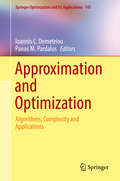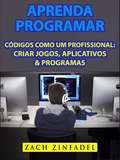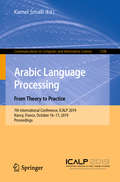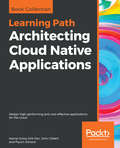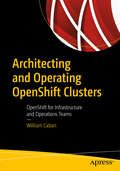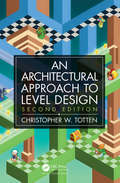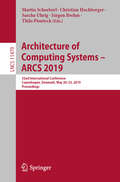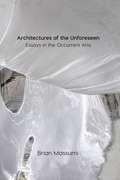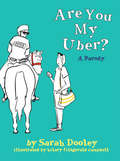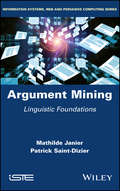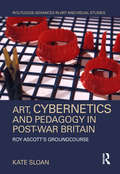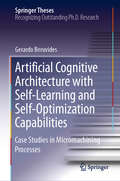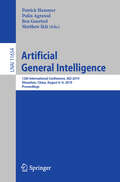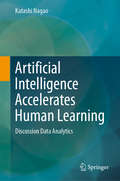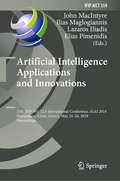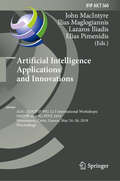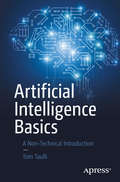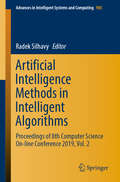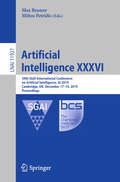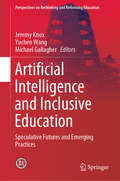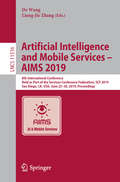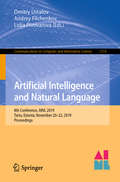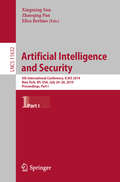- Table View
- List View
Approximation and Optimization: Algorithms, Complexity and Applications (Springer Optimization and Its Applications #145)
by Panos M. Pardalos Ioannis C. DemetriouThis book focuses on the development of approximation-related algorithms and their relevant applications. Individual contributions are written by leading experts and reflect emerging directions and connections in data approximation and optimization. Chapters discuss state of the art topics with highly relevant applications throughout science, engineering, technology and social sciences. Academics, researchers, data science practitioners, business analysts, social sciences investigators and graduate students will find the number of illustrations, applications, and examples provided useful. This volume is based on the conference Approximation and Optimization: Algorithms, Complexity, and Applications, which was held in the National and Kapodistrian University of Athens, Greece, June 29–30, 2017. The mix of survey and research content includes topics in approximations to discrete noisy data; binary sequences; design of networks and energy systems; fuzzy control; large scale optimization; noisy data; data-dependent approximation; networked control systems; machine learning ; optimal design; no free lunch theorem; non-linearly constrained optimization; spectroscopy.
Aprenda programar códigos como um Profissional: Criar jogos, Aplicativos & Programas
by Zach ZinfadelAprenda programar códigos como um Profissional: Criar jogos, Aplicativos & Programas por Zach Zinfadel Com este livro você não aprende só programação, mas também aborda tópicos que as aulas e outros livros não ensinam. Fornece também instruções específicas e fáceis de seguir, passos de como criar códigos de forma correta. Itens inclusos: - Tutoriais de programação em HTML e JavaScript. - Introdução à programação e códigos. - O que são variáveis e como usá-las. - Tudo sobre arrays e declarações lógicas. - Tudo sobre funções e como elas funcionam. - Como criar seu primeiro programa. >>> Clique acima para comprar instantaneamente! Gênero: COMPUTADORES / Programação / Geral Gênero Secundário: COMPUTADORES / Programação Web / Web Língua: Português BR
Arabic Language Processing: 7th International Conference, ICALP 2019, Nancy, France, October 16–17, 2019, Proceedings (Communications in Computer and Information Science #1108)
by Kamel SmaïliThis book constitutes revised selected papers from the 7th International Conference on Arabic Language Processing, ICALP 2019, held in Nancy, France, in October 2019. The 21 full papers presented in this volume were carefully reviewed and selected from 38 submissions. They were organized in topical sections named: Arabic dialects and sentiment analysis; neural techniques for text and speech; modeling modern standard Arabic; resources: analysis, disambiguation and evaluation.
Architecting Cloud Native Applications: Design high-performing and cost-effective applications for the cloud
by John Gilbert Kamal Arora Erik Farr Piyum ZonoozApply cloud native patterns and practices to deliver responsive, resilient, elastic, and message-driven systems with confidence Key Features Discover best practices for applying cloud native patterns to your cloud applications Explore ways to effectively plan resources and technology stacks for high security and fault tolerance Gain insight into core architectural principles using real-world examples Book Description Cloud computing has proven to be the most revolutionary IT development since virtualization. Cloud native architectures give you the benefit of more flexibility over legacy systems. This Learning Path teaches you everything you need to know for designing industry-grade cloud applications and efficiently migrating your business to the cloud. It begins by exploring the basic patterns that turn your database inside out to achieve massive scalability. You'll learn how to develop cloud native architectures using microservices and serverless computing as your design principles. Then, you'll explore ways to continuously deliver production code by implementing continuous observability in production. In the concluding chapters, you'll learn about various public cloud architectures ranging from AWS and Azure to the Google Cloud Platform, and understand the future trends and expectations of cloud providers. By the end of this Learning Path, you'll have learned the techniques to adopt cloud native architectures that meet your business requirements. This Learning Path includes content from the following Packt products: Cloud Native Development Patterns and Best Practices by John Gilbert Cloud Native Architectures by Erik Farr et al. What you will learn Understand the difference between cloud native and traditional architecture Automate security controls and configuration management Minimize risk by evolving your monolithic systems into cloud native applications Explore the aspects of migration, when and why to use it Apply modern delivery and testing methods to continuously deliver production code Enable massive scaling by turning your database inside out Who this book is for This Learning Path is designed for developers who want to progress into building cloud native systems and are keen to learn the patterns involved. Software architects, who are keen on designing scalable and highly available cloud native applications, will also find this Learning Path very useful. To easily grasp these concepts, you will need basic knowledge of programming and cloud computing.
Architecting and Operating OpenShift Clusters: OpenShift for Infrastructure and Operations Teams
by William CabanDesign and architect resilient OpenShift clusters and gain a keen understanding of how hundreds of projects are integrated into a powerful solution. While there are many OpenShift resources available for developers, this book focuses on the key elements of infrastructure and operations that teams need when looking to integrate and maintain this platform. You'll review important concepts, such as repeatable deployment techniques, advanced OpenShift RBAC capabilities, monitoring clusters, and integrating with external services. You'll also see how to run specialized workloads in OpenShift and how to deploy non-web based applications on the platform, all designed to help cultivate best practices as your organization continue evolve in microservices architectures. OpenShift has become the main enterprise Kubernetes distribution and its market penetration continues to growth at rapid rate. While OpenShift’s documentation provides a great list of configuration options to work with the platform, it can be a daunting task to wade through. Architecting and Operating OpenShift Clusters breaks this content down into clear and useful concepts to provide you with a solid understanding of the OpenShift internal architecture. What You'll Learn Operate high availability in muti-tenant OCP clusters Understand OpenShift SDN models, capabilities, and storage classes Integrate OCP with existing data center capabilities and CI/CD pipelines Support advanced capabilities like: Istio, Multus, Kubernetes Operators, hybrid deployments Who This Book Is For Cloud architects, OpenShift cluster administrators, and teams supporting developers in OpenShift environments who have a basic understanding of this platform and microservices architectures.
Architectural Approach to Level Design: Second edition
by Christopher TottenWritten by a game developer and professor trained in architecture, An Architectural Approach to Level Design is one of the first books to integrate architectural and spatial design theory with the field of level design. It explores the principles of level design through the context and history of architecture. Now in its second edition, An Architectural Approach to Level Design presents architectural techniques and theories for you to use in your own work. The author connects architecture and level design in different ways that address the practical elements of how designers construct space and the experiential elements of how and why humans interact with that space. It also addresses industry issues like how to build interesting tutorial levels and how to use computer-generated level design systems without losing the player-focused design of handmade levels. Throughout the text, you will learn skills for spatial layout, evoking emotion through gamespaces, and creating better levels through architectural theory. FEATURES Presents case studies that offer insight on modern level design practices, methods, and tools Presents perspectives from industry designers, independent game developers, scientists, psychologists, and academics Explores how historical structures can teach us about good level design Shows how to use space to guide or elicit emotion from players Includes chapter exercises that encourage you to use principles from the chapter in digital prototypes, playtesting sessions, paper mock-ups, and design journals Bringing together topics in game design and architecture, this book helps you create better spaces for your games. Software independent, the book discusses tools and techniques that you can use in crafting your interactive worlds.
Architecture of Computing Systems – ARCS 2019: 32nd International Conference, Copenhagen, Denmark, May 20–23, 2019, Proceedings (Lecture Notes in Computer Science #11479)
by Sascha Uhrig Thilo Pionteck Christian Hochberger Martin Schoeberl Jürgen BrehmThis book constitutes the proceedings of the 32nd International Conference on Architecture of Computing Systems, ARCS 2019, held in Copenhagen, Denmark, in May 2019. The 24 full papers presented in this volume were carefully reviewed and selected from 40 submissions. ARCS has always been a conference attracting leading-edge research outcomes in Computer Architecture and Operating Systems, including a wide spectrum of topics ranging from embedded and real-time systems all the way to large-scale and parallel systems. The selected papers are organized in the following topical sections: Dependable systems; real-time systems; special applications; architecture; memory hierarchy; FPGA; energy awareness; NoC/SoC. The chapter 'MEMPower: Data-Aware GPU Memory Power Model' is open access under a CC BY 4.0 license at link.springer.com.
Architectures of the Unforeseen: Essays in the Occurrent Arts
by Brian MassumiA beautifully written study of three pioneering artists, entwining their work and our understanding of creativity Bringing the creative process of three contemporary artists into conversation, Architectures of the Unforeseen stages an encounter between philosophy and art and design. Its gorgeous prose invites the reader to think along with Brian Massumi as he thoroughly embodies the work of these artists, walking the line that separates theory from art and providing equally nurturing sustenance for practicing artists and working philosophers.Based on Massumi&’s lengthy—and in two cases decades-long—relationships with digital architect Greg Lynn, interactive media artist Rafael-Lozano Hemmer, and mixed-media installation creator Simryn Gill, Architectures of the Unforeseen delves into their processes of creating art. The book&’s primary interest is in what motivates each artist&’s practice—the generative knots that inspire creativity—and in how their pieces work to give off their unique effects. More than a series of profiles or critical pieces, Massumi&’s essays are creative, developing new philosophical concepts and offering rigorous sentiments about art and creativity.Asking fundamental questions about nature, culture, and the emergence of the new, Architectures of the Unforeseen is important original research on artists that are pioneers in their field. Equally valuable to the everyday reader and those engaged in scholarly work, it is destined to become an important book not only for the fields of digital architecture, interactive media, and installation art, but also more basically for our knowledge of art and creativity.
Archives (In Search of Media)
by Andrew Lison Tomislav Medak Rick Prelinger Marcel MarsHow digital networks and services bring the issues of archives out of the realm of institutions and into the lives of everyday users Archives have become a nexus in the wake of the digital turn. Electronic files, search engines, video sites, and media player libraries make the concepts of &“archival&” and &“retrieval&” practically synonymous with the experience of interconnected computing. Archives today are the center of much attention but few agendas. Can archives inform the redistribution of power and resources when the concept of the public library as an institution makes knowledge and culture accessible to all members of society regardless of social or economic status? This book sets out to show that archives need our active support and continuing engagement. This volume offers three distinct perspectives on the present status of archives that are at once in disagreement and solidarity with each other, from contributors whose backgrounds cut across the theory–practice divide. Is the increasing digital storage of knowledge pushing us toward a turning point in its democratization? Can archives fulfill their paradoxical potential as utopian sites in which the analog and the digital, the past and future, and remembrance and forgetting commingle? Is there a downside to the present-day impulse toward total preservation?
Are You My Uber?: A Parody
by Sarah Amelia DooleyWe've all been there. You call an Uber. The app says it has arrived, but . . . where is it? Where is your Uber?Are You My Uber? is a 21st Century parody of the 1960 P.D. Eastman children's book Are You My Mother? A man steps off the midnight bus at Port Authority. His name? Unknown. His goal? To find his Uber, an elusive Ford Taurus. Lost and alone in a new city, he steels himself and begins by passing right by the very object of his search. Hilarity ensues: the man proceeds to knock at the doors of an off-duty cab, a helicopter, a halal cart, and other vehicles increasing in their absurdity, willing to try anything to find his Uber.Paired with illustrations by Hilary Fitzgerald Campbell, co-illustrator of Feminist Fight Club, Sarah Dooley's hilarious imagined story is as ridiculous as it is relatable.
Argument Mining: Linguistic Foundations
by Mathilde Janier Patrick Saint-DizierThis book is an introduction to the linguistic concepts of argumentation relevant for argument mining, an important research and development activity which can be viewed as a highly complex form of information retrieval, requiring high-level natural language processing technology. While the first four chapters develop the linguistic and conceptual aspects of argument expression, the last four are devoted to their application to argument mining. These chapters investigate the facets of argument annotation, as well as argument mining system architectures and evaluation. How annotations may be used to develop linguistic data and how to train learning algorithms is outlined. A simple implementation is then proposed. The book ends with an analysis of non-verbal argumentative discourse. Argument Mining is an introductory book for engineers or students of linguistics, artificial intelligence and natural language processing. Most, if not all, the concepts of argumentation crucial for argument mining are carefully introduced and illustrated in a simple manner.
Art, Cybernetics and Pedagogy in Post-War Britain: Roy Ascott’s Groundcourse (Routledge Advances in Art and Visual Studies)
by Kate SloanThis is the first full-length study about the British artist Roy Ascott, one of the first cybernetic artists, with a career spanning seven decades to date. The book focuses on his early career, exploring the evolution of his early interests in communication in the context of the rich overlaps between art, science and engineering in Britain during the 1950s and 1960s. The first part of the book looks at Ascott’s training and early work. The second park looks solely at Groundcourse, Ascott’s extraordinary pedagogical model for visual arts and cybernetics which used an integrative and systems-based model, drawing in behaviourism, analogue machines, performance and games. Using hitherto unpublished photographs and documents, this book will establish a more prominent place for cybernetics in post-war British art.
Artificial Cognitive Architecture with Self-Learning and Self-Optimization Capabilities: Case Studies In Micromachining Processes (Springer Theses)
by Gerardo BeruvidesThis book introduces three key issues: (i) development of a gradient-free method to enable multi-objective self-optimization; (ii) development of a reinforcement learning strategy to carry out self-learning and finally, (iii) experimental evaluation and validation in two micromachining processes (i.e., micro-milling and micro-drilling). The computational architecture (modular, network and reconfigurable for real-time monitoring and control) takes into account the analysis of different types of sensors, processing strategies and methodologies for extracting behavior patterns from representative process’ signals. The reconfiguration capability and portability of this architecture are supported by two major levels: the cognitive level (core) and the executive level (direct data exchange with the process). At the same time, the architecture includes different operating modes that interact with the process to be monitored and/or controlled. The cognitive level includes three fundamental modes such as modeling, optimization and learning, which are necessary for decision-making (in the form of control signals) and for the real-time experimental characterization of complex processes. In the specific case of the micromachining processes, a series of models based on linear regression, nonlinear regression and artificial intelligence techniques were obtained. On the other hand, the executive level has a constant interaction with the process to be monitored and/or controlled. This level receives the configuration and parameterization from the cognitive level to perform the desired monitoring and control tasks.
Artificial General Intelligence: 12th International Conference, AGI 2019, Shenzhen, China, August 6–9, 2019, Proceedings (Lecture Notes in Computer Science #11654)
by Ben Goertzel Matthew Iklé Patrick Hammer Pulin AgrawalThis book constitutes the refereed proceedings of the 12th International Conference on Artificial General Intelligence, AGI 2019, held in Shenzhen, China, in August 2019. The 16 full papers and 5 poster papers presented in this book were carefully reviewed and selected from 30 submissions. The papers are covering AGI architectures, discussing mathematical foundations, philosophical foundations, safety and ethics, and developing ideas from neuroscience and cognitive science.
Artificial Intelligence Accelerates Human Learning: Discussion Data Analytics
by Katashi NagaoFocusing on students’ presentations and discussions in laboratory seminars, this book presents case studies on evidence-based education using artificial intelligence (AI) technologies. It proposes a system to help users complete research activities, and a machine-learning method that makes the system suitable for long-term operation by performing data mining for discussions and automatically extracting essential tasks. By illustrating the complete process – proposal, implementation, and operation – of applying machine learning techniques to real-world situations, the book will inspire researchers and professionals to develop innovative new applications for education. The book is divided into six chapters, the first of which provides an overview of AI research and practice in education. In turn, Chapter 2 describes a mechanism for applying data analytics to student discussions and utilizing the results for knowledge creation activities such as research. Based on discussion data analytics, Chapter 3 describes a creative activity support system that effectively utilizes the analytical results of the discussion for subsequent activities. Chapter 4 discusses the incorporation of a gamification method to evaluate and improve discussion skills while maintaining the motivation to participate in the discussion. Chapters 5 and 6 describe an advanced learning environment for honing students’ discussion and presentation skills. Two important systems proposed here are a presentation training system using virtual reality technologies, and an interactive presentation/discussion training system using a humanoid robot. In the former, the virtual space is constructed by measuring the three-dimensional shape of the actual auditorium, presentations are performed in the same way as in the real world, and the AI as audience automatically evaluates the presentation and provides feedback. In the latter, a humanoid robot makes some remarks on and asks questions about students’ presentations, and the students practice responding to it.
Artificial Intelligence Applications and Innovations: 15th IFIP WG 12.5 International Conference, AIAI 2019, Hersonissos, Crete, Greece, May 24–26, 2019, Proceedings (IFIP Advances in Information and Communication Technology #559)
by Elias Pimenidis Lazaros Iliadis Ilias Maglogiannis John MacIntyreThis book constitutes the refereed proceedings of the 15th IFIP WG 12.5 International Conference on Artificial Intelligence Applications and Innovations, AIAI 2019, held in Hersonissos, Crete, Greece, in May 2019.The 49 full papers and 6 short papers presented were carefully reviewed and selected from 101 submissions. They cover a broad range of topics such as deep learning ANN; genetic algorithms - optimization; constraints modeling; ANN training algorithms; social media intelligent modeling; text mining/machine translation; fuzzy modeling; biomedical and bioinformatics algorithms and systems; feature selection; emotion recognition; hybrid Intelligent models; classification - pattern recognition; intelligent security modeling; complex stochastic games; unsupervised machine learning; ANN in industry; intelligent clustering; convolutional and recurrent ANN; recommender systems; intelligent telecommunications modeling; and intelligent hybrid systems using Internet of Things. The papers are organized in the following topical sections:AI anomaly detection - active learning; autonomous vehicles - aerial vehicles; biomedical AI; classification - clustering; constraint programming - brain inspired modeling; deep learning - convolutional ANN; fuzzy modeling; learning automata - logic based reasoning; machine learning - natural language; multi agent - IoT; nature inspired flight and robot; control - machine vision; and recommendation systems.
Artificial Intelligence Applications and Innovations: AIAI 2019 IFIP WG 12.5 International Workshops: MHDW and 5G-PINE 2019, Hersonissos, Crete, Greece, May 24–26, 2019, Proceedings (IFIP Advances in Information and Communication Technology #560)
by Elias Pimenidis Lazaros Iliadis Ilias Maglogiannis John MacIntyreThis book constitutes the refereed proceedings of two International Workshops held as parallel events of the 15th IFIP WG 12.5 International Conference on Artificial Intelligence Applications and Innovations, AIAI 2019, in Hersonissos, Crete, Greece, in May 2019: the 8th Mining Humanistic Data Workshop, MHDW 2019, and the 4th Workshop on 5G-Putting Intelligence to the Network Edge, 5G-PINE 2019.The 6 full papers and 4 short papers presented at MHDW 2019 were carefully reviewed and selected from 13 submissions; out of the 14 papers submitted to 5G-PINE 2019, 6 were accepted as full papers and 1 as short paper. The MHDW papers focus on the application of innovative as well as existing data matching, fusion and mining and knowledge discovery and management techniques (such as decision rules, decision trees, association rules, ontologies and alignments, clustering, filtering, learning, classifier systems, neural networks, support vector machines, preprocessing, post processing, feature selection, visualization techniques) to data derived from all areas of humanistic sciences, e.g., linguistic, historical, behavioral, psychological, artistic, musical, educational, social, and ubiquitous computing and bioinformatics. The papers presented at 5G-PINE focus on several innovative findings coming directly from modern European research in the area of modern 5G telecommunications infrastructures and related innovative services and cover a wide variety of technical and business aspects promoting options for growth and development.
Artificial Intelligence Basics: A Non-Technical Introduction
by Tom TaulliArtificial intelligence touches nearly every part of your day. While you may initially assume that technology such as smart speakers and digital assistants are the extent of it, AI has in fact rapidly become a general-purpose technology, reverberating across industries including transportation, healthcare, financial services, and many more. In our modern era, an understanding of AI and its possibilities for your organization is essential for growth and success.Artificial Intelligence Basics has arrived to equip you with a fundamental, timely grasp of AI and its impact. Author Tom Taulli provides an engaging, non-technical introduction to important concepts such as machine learning, deep learning, natural language processing (NLP), robotics, and more. In addition to guiding you through real-world case studies and practical implementation steps, Taulli uses his expertise to expand on the bigger questions that surround AI. These include societal trends, ethics, and future impact AI will have on world governments, company structures, and daily life. Google, Amazon, Facebook, and similar tech giants are far from the only organizations on which artificial intelligence has had—and will continue to have—an incredibly significant result. AI is the present and the future of your business as well as your home life. Strengthening your prowess on the subject will prove invaluable to your preparation for the future of tech, and Artificial Intelligence Basics is the indispensable guide that you’ve been seeking. What You Will LearnStudy the core principles for AI approaches such as machine learning, deep learning, and NLP (Natural Language Processing)Discover the best practices to successfully implement AI by examining case studies including Uber, Facebook, Waymo, UiPath, and Stitch FixUnderstand how AI capabilities for robots can improve businessDeploy chatbots and Robotic Processing Automation (RPA) to save costs and improve customer serviceAvoid costly gotchasRecognize ethical concerns and other risk factors of using artificial intelligenceExamine the secular trends and how they may impact your business Who This Book Is For Readers without a technical background, such as managers, looking to understand AI to evaluate solutions.
Artificial Intelligence Methods in Intelligent Algorithms: Proceedings of 8th Computer Science On-line Conference 2019, Vol. 2 (Advances in Intelligent Systems and Computing #985)
by Radek SilhavyThis book discusses the current trends in and applications of artificial intelligence research in intelligent systems. Including the proceedings of the Artificial Intelligence Methods in Intelligent Algorithms Section of the 8th Computer Science On-line Conference 2019 (CSOC 2019), held in April 2019, it features papers on neural networks algorithms, optimisation algorithms and real-world issues related to the application of artificial methods.
Artificial Intelligence XXXVI: 39th SGAI International Conference on Artificial Intelligence, AI 2019, Cambridge, UK, December 17–19, 2019, Proceedings (Lecture Notes in Computer Science #11927)
by Max Bramer Miltos PetridisThis book constitutes the proceedings of the 39th SGAI International Conference on Innovative Techniques and Applications of Artificial Intelligence, AI 2019, held in Cambridge, UK, in December 2019.The 29 full papers and 14 short papers presented in this volume were carefully reviewed and selected from 49 submissions. The volume includes technical papers presenting new and innovative developments in the field as well as application papers presenting innovative applications of AI techniques in a number of subject domains. The papers are organized in the following topical sections: machine learning; knowledge discovery and data mining; agents, knowledge acquisition and ontologies; medical applications; applications of evolutionary algorithms; machine learning for time series data; applications of machine learning; and knowledge acquisition.
Artificial Intelligence and Conservation (Artificial Intelligence for Social Good)
by Milind Tambe Fei Fang Bistra Dilkina Andrew J. PlumptreWith the increasing public interest in artificial intelligence (AI), there is also increasing interest in learning about the benefits that AI can deliver to society. This book focuses on research advances in AI that benefit the conservation of wildlife, forests, coral reefs, rivers, and other natural resources. It presents how the joint efforts of researchers in computer science, ecology, economics, and psychology help address the goals of the United Nations' 2030 Agenda for Sustainable Development. Written at a level accessible to conservation professionals and AI researchers, the book offers both an overview of the field and an in-depth view of how AI is being used to understand patterns in wildlife poaching and enhance patrol efforts in response, covering research advances, field tests and real-world deployments. The book also features efforts in other major conservation directions, including protecting natural resources, ecosystem monitoring, and bio-invasion management through the use of game theory, machine learning, and optimization.
Artificial Intelligence and Inclusive Education: Speculative Futures and Emerging Practices (Perspectives on Rethinking and Reforming Education)
by Michael Gallagher Jeremy Knox Yuchen WangThis book brings together the fields of artificial intelligence (often known as A.I.) and inclusive education in order to speculate on the future of teaching and learning in increasingly diverse social, cultural, emotional, and linguistic educational contexts. This book addresses a pressing need to understand how future educational practices can promote equity and equality, while at the same time adopting A.I. systems that are oriented towards automation, standardisation and efficiency. The contributions in this edited volume appeal to scholars and students with an interest in forming a critical understanding of the development of A.I. for education, as well as an interest in how the processes of inclusive education might be shaped by future technologies. Grounded in theoretical engagement, establishing key challenges for future practice, and outlining the latest research, this book offers a comprehensive overview of the complex issues arising from the convergence of A.I. technologies and the necessity of developing inclusive teaching and learning.To date, there has been little in the way of direct association between research and practice in these domains: A.I. has been a predominantly technical field of research and development, and while intelligent computer systems and ‘smart’ software are being increasingly applied in many areas of industry, economics, social life, and education itself, a specific engagement with the agenda of inclusion appears lacking. Although such technology offers exciting possibilities for education, including software that is designed to ‘personalise’ learning or adapt to learner behaviours, these developments are accompanied by growing concerns about the in-built biases involved in machine learning techniques driven by ‘big data’.
Artificial Intelligence and Mobile Services – AIMS 2019: 8th International Conference, Held as Part of the Services Conference Federation, SCF 2019, San Diego, CA, USA, June 25–30, 2019, Proceedings (Lecture Notes in Computer Science #11516)
by Liang-Jie Zhang De WangThis book constitutes the proceedings of the 8th International Conference on Artificial Intelligence and Mobile Services, AIMS 2019, held as part of SCF 2019, in San Diego, CA, USA, in June 2019. The 12 full papers and one short paper presented were carefully reviewed and selected from 29 submissions. The papers cover different aspects of mobile services from business management to computing systems, algorithms and applications. They promote technological technological innovations in research and development of mobile services, including, but not limited to, wireless and sensor networks, mobile and wearable computing, mobile enterprise and eCommerce, ubiquitous collaborative and social services, machine-to-machine and Internet-of-things, clouds, cyber-physical integration, and big data analytics for mobility-enabled services.
Artificial Intelligence and Natural Language: 8th Conference, AINL 2019, Tartu, Estonia, November 20–22, 2019, Proceedings (Communications in Computer and Information Science #1119)
by Andrey Filchenkov Lidia Pivovarova Dmitry UstalovThis book constitutes the refereed proceedings of the 8th Conference on Artificial Intelligence and Natural Language, AINL 2019, held in Tartu, Estonia, in November 2019. The 10 revised full papers and 2 short papers were carefully reviewed and selected from 34 submissions. The papers are organized according to the following topics: data acquisition and annotation; human-computer interaction; statistical natural language processing; neural language models.
Artificial Intelligence and Security: 5th International Conference, ICAIS 2019, New York, NY, USA, July 26-28, 2019, Proceedings, Part I (Lecture Notes in Computer Science #11632)
by Elisa Bertino Xingming Sun Zhaoqing PanThe 4-volume set LNCS 11632 until LNCS 11635 constitutes the refereed proceedings of the 5th International Conference on Artificial Intelligence and Security, ICAIS 2019, which was held in New York, USA, in July 2019. The conference was formerly called “International Conference on Cloud Computing and Security” with the acronym ICCCS.The total of 230 full papers presented in this 4-volume proceedings was carefully reviewed and selected from 1529 submissions. The papers were organized in topical sections as follows: Part I: cloud computing; Part II: artificial intelligence; big data; and cloud computing and security; Part III: cloud computing and security; information hiding; IoT security; multimedia forensics; and encryption and cybersecurity; Part IV: encryption and cybersecurity.
